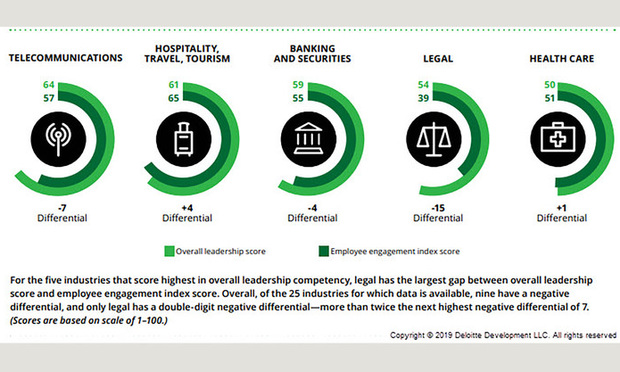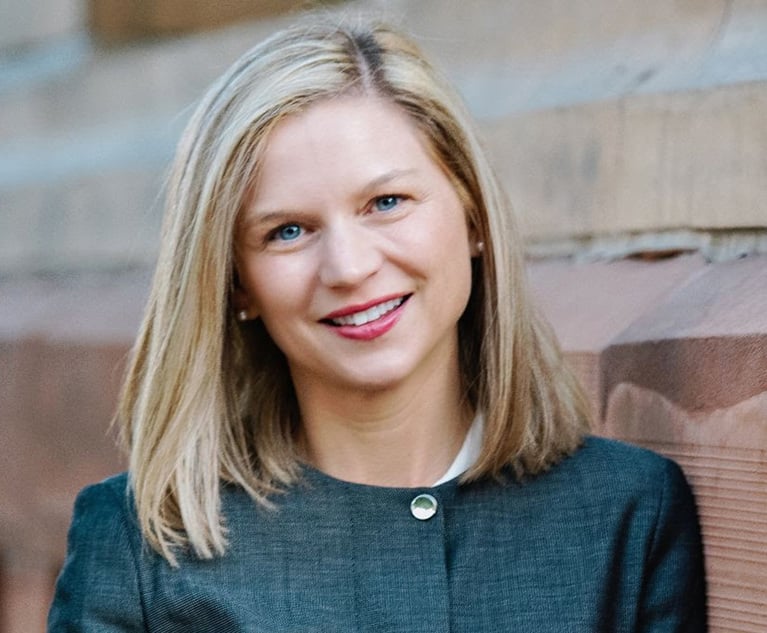Examining the Disconnect Between In-House Leaders and Legal Teams
"Maybe we're not taking enough responsibility as leaders for the way that we structure our environment or ecosystem within the legal department," said Lori Lorenzo, managing director of Deloitte's chief legal officer program.
December 11, 2019 at 03:46 PM
4 minute read
 Photo: Shutterstock.com
Photo: Shutterstock.com
General counsel and chief legal officers are struggling to engage with other lawyers in their legal departments—even those who are being groomed to take on in-house leadership roles, according to a new report from Deloitte.
"Maybe we're not taking enough responsibility as leaders for the way that we structure our environment or ecosystem within the legal department," said Lori Lorenzo, managing director of Deloitte's chief legal officer program.
The Big Four accounting firm's "Chief Legal Officers and Leadership" report is based, in part, on phone interviews with 101 pairs of predominantly U.S.-based in-house leaders and lawyers that those same leaders identified as rising stars in their corporate legal departments.
The report also examined data from a Zenger Folkman survey of more than 122,000 executives in telecom, hospitality, banking, health care and legal sectors. The survey found that the employee engagement disconnect is far more pronounced in legal departments than in any of the other included industries.
 Photo courtesy of Deloitte
Photo courtesy of DeloitteBut E. Leigh Dance, a management consultant for global corporate legal departments and president of ELD International, was skeptical.
"I meet with general counsel mostly and I find that their connection to their team is really close and really interactive, by necessity," she said. "Generally, my impression has been that general counsel are very involved one to two levels down."
During the Deloitte interviews, GCs and CLOs were asked to identify their aspiring leaders' top three leadership strengths. In separate discussions, the aspiring leaders were asked to list their own leadership strengths.
Of all the participants, only one pair gave answers that were completely aligned, according to Lorenzo. The primary disconnect, she said, was that most aspiring leaders thought of themselves as strategic business partners, while the actual leaders said the lower-level lawyers still needed to develop that skill.
Lorenzo suggested that the misalignment could be a "matter of perspective and definition. From a CLO's more elevated view, the way a strategic business partnership looks is perhaps different than if you're the head of litigation or the GC of a division."
She noted that top lawyers said in the interviews that their proteges needed to build stronger relationships with leaders throughout the company before they could move into higher roles within the legal department.
Dance, the consultant, said general counsel often want to give the stars of their legal teams the opportunity to present to the board of directors or take on other leadership responsibilities that provide exposure to the C-suite.
"Many of them will try, but a lot of times the director will say, 'No, we want you, the GC,'" she added. "I see deputies to GCs often being overlooked when the top person leaves because they aren't perceived by the executive team as someone who could fill their shoes."
Another disconnect emerged when the interviewees were asked to list the top three areas that rising leaders should be focused on for development. Most of the lower-level lawyers identified technical savvy—a skill that wasn't on the radar of most CLOs.
"I want to do more research about why there is that disconnect," Lorenzo said. "But this is interesting, especially in what I call the age of legal transformation."
Leaders should be looking more closely at legal technology as a way to make legal departments more efficient but also as an opportunity to engage with their in-house lawyers by, for instance, giving them the chance to develop new skills or take on different responsibilities.
"CLOs have a wonderful opportunity right now," Lorenzo said. "We're in a place where we can be thinking differently about what it looks like to work in-house and the types of training we give our lawyers access to and the types of learning, development and practice experiences that we provide."
This content has been archived. It is available through our partners, LexisNexis® and Bloomberg Law.
To view this content, please continue to their sites.
Not a Lexis Subscriber?
Subscribe Now
Not a Bloomberg Law Subscriber?
Subscribe Now
NOT FOR REPRINT
© 2025 ALM Global, LLC, All Rights Reserved. Request academic re-use from www.copyright.com. All other uses, submit a request to [email protected]. For more information visit Asset & Logo Licensing.
You Might Like
View All
Ad Agency Legal Chief Scores $12M Golden Parachute in $13B Sale to Rival
3 minute read

FTC Sues PepsiCo for Alleged Price Break to Big-Box Retailer, Incurs Holyoak's Wrath
5 minute readTrending Stories
- 1Decision of the Day: Judge Dismisses Defamation Suit by New York Philharmonic Oboist Accused of Sexual Misconduct
- 2California Court Denies Apple's Motion to Strike Allegations in Gender Bias Class Action
- 3US DOJ Threatens to Prosecute Local Officials Who Don't Aid Immigration Enforcement
- 4Kirkland Is Entering a New Market. Will Its Rates Get a Warm Welcome?
- 5African Law Firm Investigated Over ‘AI-Generated’ Case References
Who Got The Work
J. Brugh Lower of Gibbons has entered an appearance for industrial equipment supplier Devco Corporation in a pending trademark infringement lawsuit. The suit, accusing the defendant of selling knock-off Graco products, was filed Dec. 18 in New Jersey District Court by Rivkin Radler on behalf of Graco Inc. and Graco Minnesota. The case, assigned to U.S. District Judge Zahid N. Quraishi, is 3:24-cv-11294, Graco Inc. et al v. Devco Corporation.
Who Got The Work
Rebecca Maller-Stein and Kent A. Yalowitz of Arnold & Porter Kaye Scholer have entered their appearances for Hanaco Venture Capital and its executives, Lior Prosor and David Frankel, in a pending securities lawsuit. The action, filed on Dec. 24 in New York Southern District Court by Zell, Aron & Co. on behalf of Goldeneye Advisors, accuses the defendants of negligently and fraudulently managing the plaintiff's $1 million investment. The case, assigned to U.S. District Judge Vernon S. Broderick, is 1:24-cv-09918, Goldeneye Advisors, LLC v. Hanaco Venture Capital, Ltd. et al.
Who Got The Work
Attorneys from A&O Shearman has stepped in as defense counsel for Toronto-Dominion Bank and other defendants in a pending securities class action. The suit, filed Dec. 11 in New York Southern District Court by Bleichmar Fonti & Auld, accuses the defendants of concealing the bank's 'pervasive' deficiencies in regards to its compliance with the Bank Secrecy Act and the quality of its anti-money laundering controls. The case, assigned to U.S. District Judge Arun Subramanian, is 1:24-cv-09445, Gonzalez v. The Toronto-Dominion Bank et al.
Who Got The Work
Crown Castle International, a Pennsylvania company providing shared communications infrastructure, has turned to Luke D. Wolf of Gordon Rees Scully Mansukhani to fend off a pending breach-of-contract lawsuit. The court action, filed Nov. 25 in Michigan Eastern District Court by Hooper Hathaway PC on behalf of The Town Residences LLC, accuses Crown Castle of failing to transfer approximately $30,000 in utility payments from T-Mobile in breach of a roof-top lease and assignment agreement. The case, assigned to U.S. District Judge Susan K. Declercq, is 2:24-cv-13131, The Town Residences LLC v. T-Mobile US, Inc. et al.
Who Got The Work
Wilfred P. Coronato and Daniel M. Schwartz of McCarter & English have stepped in as defense counsel to Electrolux Home Products Inc. in a pending product liability lawsuit. The court action, filed Nov. 26 in New York Eastern District Court by Poulos Lopiccolo PC and Nagel Rice LLP on behalf of David Stern, alleges that the defendant's refrigerators’ drawers and shelving repeatedly break and fall apart within months after purchase. The case, assigned to U.S. District Judge Joan M. Azrack, is 2:24-cv-08204, Stern v. Electrolux Home Products, Inc.
Featured Firms
Law Offices of Gary Martin Hays & Associates, P.C.
(470) 294-1674
Law Offices of Mark E. Salomone
(857) 444-6468
Smith & Hassler
(713) 739-1250







